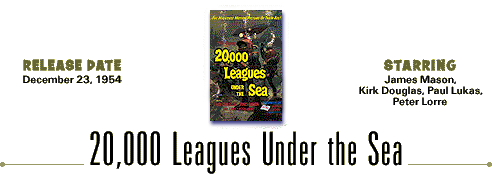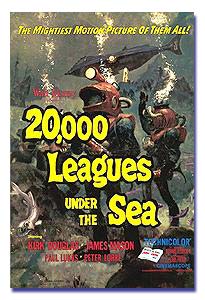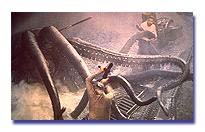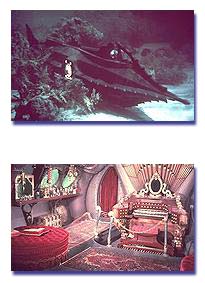 |
 |
 |
 n 1868 an armed frigate, sent to seek out a fabled
destroyer of ships, is itself sunk and three passengers from the
frigate are rescued: a harpooner, Ned Land, a professor, who is an
expert on the creatures of the sea, and his assistant. They
discover that the "monster" that they were searching for was in
reality the first man-made submarine, the Nautilus, commanded by
Captain Nemo, a madman who is only willing to share his secrets of
nuclear energy with the world on his own terms. Land rescues Nemo
from the clutches of a giant squid and eventually manages to alert
the outside world to the location of Nemo's secret island base, and
Nemo and his creations are destroyed. n 1868 an armed frigate, sent to seek out a fabled
destroyer of ships, is itself sunk and three passengers from the
frigate are rescued: a harpooner, Ned Land, a professor, who is an
expert on the creatures of the sea, and his assistant. They
discover that the "monster" that they were searching for was in
reality the first man-made submarine, the Nautilus, commanded by
Captain Nemo, a madman who is only willing to share his secrets of
nuclear energy with the world on his own terms. Land rescues Nemo
from the clutches of a giant squid and eventually manages to alert
the outside world to the location of Nemo's secret island base, and
Nemo and his creations are destroyed. |
|
 |

The first Disney feature filmed in CinemaScope®. Disney
special-effects wizards constructed the giant squid of rubber,
steel spring, flexible tubing, glass cloth, lucite, and plastic,
with tentacles measuring 40 feet with two feelers of 50 feet. It
could rear up eight feet out of the water, its tentacles and
feelers moving with frightening realism. It took a staff of 28 men
to operate the intricate remote controls. Using hydraulics,
electronics, and compressed air, they succeeded in giving a
life-like appearance to the squid. But there were problems. The
squid fight had to be filmed a second time after Walt Disney and
the director, Richard Fleischer, were unhappy with the initial
results. It had been filmed in a special tank on brand-new sound
stage 3 at the Disney Studio as if it were sunset on a placid sea;
unfortunately this allowed one a view of too much of the mechanics
that enabled the squid to move, and it looked fake. The scene was
shot a second time, as if it were a stormy night, with 100
backstage workers on hand providing the needed lightning, rain,
turbulent seas, and hurricane winds, and the illusion was
perfect. |
|
 |

Based on the classic story by Jules Verne. Academy Award®
winner for Best Special Effects and Best Art Decoration/Set
Decoration (John Meehan and Emile Kuri); nominated also for Best
Film Editing. 127 min. The movie featured the song "A Whale of a
Tale" by Al Hoffman and Norman Gimbel. Director Fleischer was the
son of Walt's early animation rival, Max Fleischer, who had created
the Out of the Inkwell and Betty Boop cartoons, and Walt made sure
that Max did not object before he hired his son. Locations for the
film included the Disney and 20th Century Fox lots in California,
and various locales in The Bahamas and Jamaica. The Nautilus was
designed by Harper Goff. Reissued in theaters in 1963 and 1971.
Released on video in 1980, 1985, and 1992. A television show on the
making of the film, "Operation Undersea," won the Emmy for best
television program of the year. The Nautilus set was displayed for
a time at Disneyland® Park. |
|
 |
 |
|
|
 |
 |
 |
|
|
 |
|
 |